Digital marketing for architects offers techniques to showcase their work, engage with potential clients, and build their brand. This comprehensive guide explores various aspects of digital marketing tailored for architects, detailing how each component can be effectively utilized to boost your online presence and business growth.
Why Digital Marketing for Architects and Architecture Firms Is Required
- Increased Visibility: Digital marketing for architects significantly expands your reach, allowing more potential clients to discover your architectural services online.
- Showcasing Portfolio: It provides a platform to showcase your work and projects to a broader audience, enhancing your portfolio’s visibility.
- Targeted Marketing: Digital marketing enables precise targeting of your ideal client base, whether they are homeowners, businesses, or property developers.
- Building Brand Authority: Regularly sharing content and insights about architecture establishes your firm as an authority in the field.
- Engagement with Clients: It creates opportunities for direct engagement with clients and prospects, fostering stronger relationships and trust.
- Cost-Effective: Compared to traditional marketing methods, digital marketing can be more cost-effective, offering a better return on investment.
- Measurable Results: Digital marketing provides measurable metrics, allowing you to track the success of campaigns and adjust strategies accordingly.
- Adaptability to Market Trends: It enables quick adaptation to market changes and client preferences, keeping your firm relevant and competitive.
Understanding the Marketing Funnel for Architects
The marketing funnel is a vital framework for architects to understand and utilize in their digital marketing strategies. It outlines the customer’s journey from initial awareness of your brand to the final decision to engage your services. Let’s delve deeper into each stage of the funnel and explore specific tactics and tools that can be effectively applied in the context of architecture.
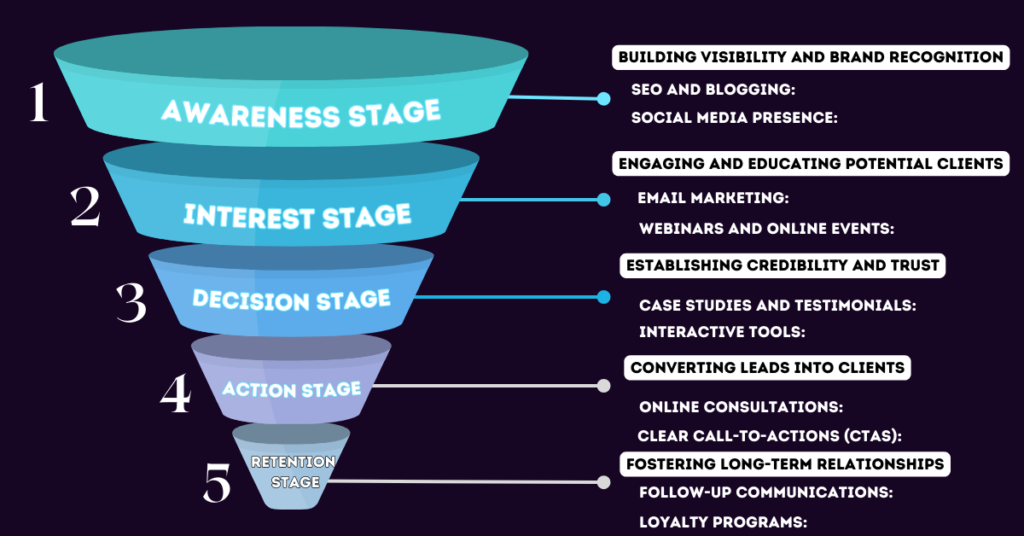
1. Awareness Stage: Building Visibility and Brand Recognition
- SEO and Blogging:
- Keyword Research: Identify keywords that potential clients might use to find architectural services. Tools like Google Keyword Planner can help.
- SEO-Optimized Content: Create blog posts that answer common architecture-related queries, discuss design trends, and showcase your expertise.
- Social Media Presence:
- Platform Strategy: Choose platforms where your target audience is most active. Instagram is great for visual content, while LinkedIn is ideal for professional networking.
- Consistent Branding: Maintain a consistent brand image and voice across all platforms to increase brand recognition.
2. Interest Stage: Engaging and Educating Potential Clients
- Email Marketing:
- Lead Magnets: Offer valuable resources like eBooks or design guides in exchange for email subscriptions.
- Drip Campaigns: Implement automated email sequences that gradually provide more information and nurture leads.
- Webinars and Online Events:
- Topics of Interest: Host webinars on topics like sustainable architecture, modern design trends, or historical restoration.
- Guest Speakers: Collaborate with other industry experts to add credibility and attract a wider audience.
3. Decision Stage: Establishing Credibility and Trust
- Case Studies and Testimonials:
- Detailed Project Overviews: Use case studies to demonstrate your approach to problem-solving and innovation in design.
- Client Feedback: Showcase testimonials and reviews from previous clients to build trust with prospects.
- Interactive Tools:
- Virtual Reality (VR): Implement VR technology to offer immersive previews of your designs.
- Design Simulators: Allow potential clients to experiment with different design elements through online tools.
4. Action Stage: Converting Leads into Clients
- Online Consultations:
- Easy Scheduling: Integrate a scheduling tool on your website for hassle-free appointment bookings.
- Initial Consultation Offers: Consider offering a free initial consultation to attract potential clients.
- Clear Call-to-Actions (CTAs):
- Strategic Placement: Position CTAs prominently on your website and in your emails.
- Compelling Copy: Use persuasive language that encourages action, such as “Schedule Your Free Consultation Today!”
5. Retention Stage: Fostering Long-term Relationships
- Follow-up Communications:
- Post-Project Surveys: Send surveys to gather feedback and suggestions for improvement.
- Regular Updates: Keep past clients informed about new services, projects, or firm news.
- Loyalty Programs:
- Referral Incentives: Offer incentives for clients who refer new business to your firm.
- Exclusive Offers: Provide returning clients with special offers or early access to new services.
By understanding and effectively utilizing each stage of the marketing funnel, architects can create a comprehensive digital marketing strategy for architectsthat not only attracts potential clients but also nurtures and retains them. This approach ensures a steady pipeline of leads and establishes a strong, loyal client base for sustainable business growth.
Leveraging Digital Marketing Channels For Architecture Firms
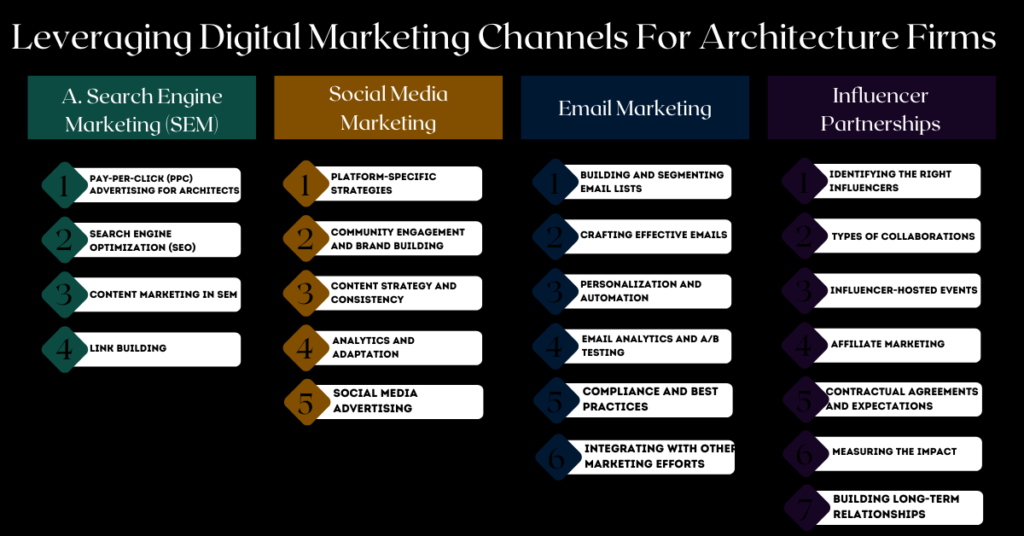
To maximize the impact of their digital marketing efforts, architects need to effectively utilize a variety of channels. Each channel serves a unique purpose and reaches different segments of the audience. Here’s an expanded look at key digital marketing channels and how architects can leverage them:
A. Search Engine Marketing (SEM)
Search Engine Marketing (SEM) is a critical component of an architect’s digital marketing strategy. It encompasses a range of tactics to increase visibility on search engine results pages (SERPs) and attract targeted traffic. Here’s a deeper look into SEM strategies specifically tailored for architects:
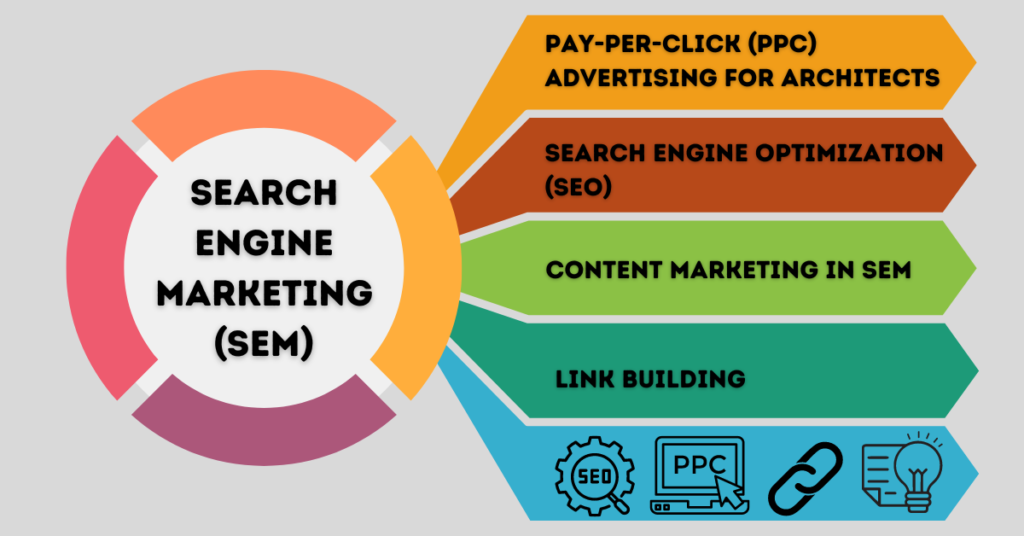
1. Pay-Per-Click (PPC) Advertising for Architects
- Keyword Strategy:
- Service-Specific Keywords: Bid on keywords related to your specific architectural services, like “residential architecture,” “sustainable design,” or “commercial architects.”
- Geo-Targeted Keywords: Include location-based keywords, such as “architects in [City]” or “architecture firms near me.”
- Ad Copy and Design:
- Compelling Headlines: Craft ad headlines that clearly state your unique value proposition, like “Award-Winning Sustainable Architecture.”
- Visuals: Use high-quality images or graphics in display ads to showcase your work and attract attention.
- Optimizing Landing Pages:
- Relevance: Ensure the landing page content is optimized and directly relevant to the ad. If the ad promotes residential architecture services, the landing page should focus on this.
- Call to Action: Include clear calls to action (CTAs), such as “Book a Consultation” or “View Portfolio.”
- Budget and Bidding:
- Cost-Effective Bidding: Start with a conservative budget and adjust based on the performance of different keywords and ad sets.
- Bid Adjustments: Use bid adjustments to increase visibility during peak times or in high-value locations.
2. Search Engine Optimization (SEO)
- On-Page SEO:
- Quality Content: Publish high-quality, informative content on your website, focusing on topics related to architecture, design trends, and case studies.
- Keyword Optimization: Incorporate relevant keywords naturally into your website’s content, titles, and meta descriptions.
- Local SEO:
- Google My Business Optimization: Claim and optimize your Google My Business listing with accurate and detailed information, including services offered, contact details, and high-quality images.
- Local Citations: Ensure your firm is listed in local business directories and architecture-specific directories.
- Technical SEO:
- Website Speed: Optimize your website’s loading speed as it affects user experience and search rankings.
- Mobile Responsiveness: Ensure your website is mobile-friendly, considering more users are likely to search on mobile devices.
3. Content Marketing in SEM
- Educational Blog Posts:
- Architecture Guides: Write guides on architectural styles, processes, or design tips.
- Project Case Studies: Share in-depth case studies of your projects, highlighting the challenges, solutions, and outcomes.
- Multimedia Content:
- Videos and Virtual Tours: Include videos or virtual tours of your projects, which can improve user engagement and time spent on your site.
- Infographics: Create infographics about architectural concepts or project timelines that are shareable and informative.
4. Link Building
- Quality Backlinks:
- Guest Posting: Write guest articles for reputable architecture or design websites.
- Industry Partnerships: Collaborate with related businesses or suppliers for mutual promotion and linking.
- Local Link Building:
- Community Involvement: Participate in local events or sponsorships and get featured on local community websites.
- Local News Coverage: Engage with local media for coverage of your projects or community initiatives.
B. Social Media Marketing
Social media marketing is a powerful tool for architects, allowing them to showcase their work, build brand awareness, and engage with both potential clients and peers. Here’s a more detailed look at how architects can leverage various social media platforms:
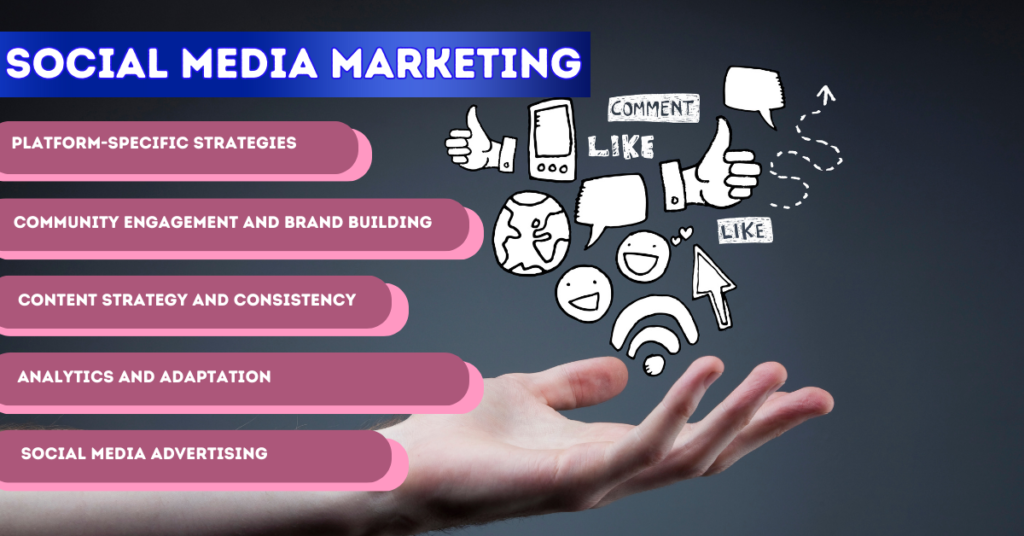
Platform-Specific Strategies
- Instagram:
- Visual Portfolio: Regularly post high-quality images and videos of your projects. Use before-and-after shots, time-lapse videos of the design process, and final results.
- Stories and Reels: Utilize Instagram Stories and Reels for more dynamic content, like site visits, client testimonials, or quick design tips.
- Hashtags: Use relevant hashtags (#Architecture, #ModernDesign, etc.) to reach a wider audience and appear in search results.
- LinkedIn:
- Professional Networking: Connect with industry professionals, join architecture groups, and participate in discussions.
- Publish Articles: Write and publish articles on LinkedIn about industry trends, insights, or case studies to establish thought leadership.
- Company Page: Maintain an active company page to post updates, job openings, and industry news.
- Facebook:
- Community Engagement: Create a Facebook Page for your firm to share project updates, news, and engage with your audience through comments and messages.
- Facebook Live: Host live sessions to give virtual tours of ongoing projects or Q&A sessions about architecture.
- Pinterest:
- Idea Boards: Create boards for different projects, design ideas, or architectural styles.
- Project Galleries: Use high-resolution images of your projects with links to your website.
- YouTube:
- Channel for Branding: Develop a YouTube channel dedicated to showcasing your projects, client testimonials, and educational content about architecture.
- Video SEO: Optimize video titles, descriptions, and tags to improve visibility in search results.
Community Engagement and Brand Building
- User-Generated Content:
- Encourage clients to share their experiences and photos of your projects. Feature these stories on your social media.
- Interactive Posts:
- Create polls, ask questions, or host competitions to encourage audience interaction.
- Collaborations and Features:
- Collaborate with interior designers, landscape architects, and other professionals for joint projects and social media features.
Content Strategy and Consistency
- Content Calendar:
- Develop a content calendar to plan and schedule posts in advance, ensuring a consistent online presence.
- Diverse Content Formats:
- Use a mix of images, videos, infographics, and text posts to keep your content engaging and diverse.
Analytics and Adaptation
- Tracking and Analytics:
- Regularly review analytics provided by each platform to understand which types of content are most engaging and effective.
- Adaptation and Experimentation:
- Be willing to adapt your strategy based on what resonates with your audience. Experiment with new content formats or trends.
Social Media Advertising
- Targeted Advertising:
- Utilize the advertising tools on platforms like Facebook and Instagram to target specific demographics, locations, and interests.
- Retargeting Campaigns:
- Implement retargeting ads to re-engage visitors who have interacted with your website or social media pages.
By effectively using social media, architects can not only showcase their work and expertise but also build meaningful connections with their audience, enhancing their brand’s reputation and reach. It’s important to maintain authenticity and engage genuinely with followers to foster long-term relationships and trust.
C. Email Marketing
Email marketing remains one of the most effective digital marketing tools, offering architects a direct line of communication with potential and existing clients. Here’s an in-depth look at how architects can harness the power of email marketing:
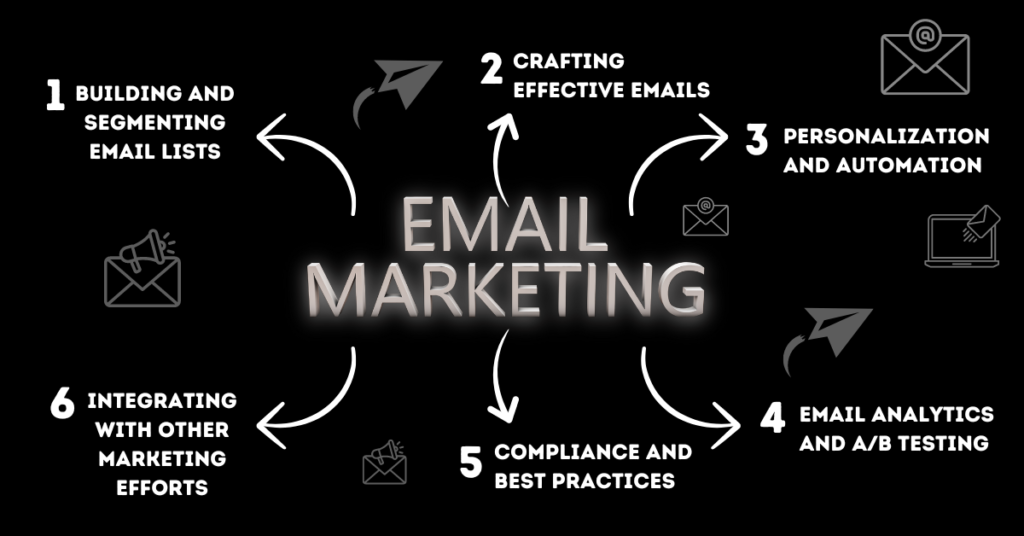
1. Building and Segmenting Email Lists
- Lead Generation:
- Utilize your website, blog, and social media channels to encourage sign-ups. Offer valuable resources like design guides, eBooks, or newsletters in exchange for email addresses.
- Implement sign-up forms at events or during client meetings.
- Segmentation:
- Segment your email list based on criteria like interests (residential, commercial architecture), engagement level (new subscribers, active clients, past clients), and behavior (those who clicked on specific links, attended webinars, etc.).
- Tailored content for each segment ensures more personalized and relevant communication.
2. Crafting Effective Emails
- Subject Lines:
- Write compelling subject lines that encourage recipients to open the email. Test different styles (question, teaser, direct statement) to see what works best for your audience.
- Content and Design:
- Ensure the content is relevant, informative, and engaging. This could include project updates, architectural trends, tips, and company news.
- Use a responsive email design that looks good on both desktop and mobile devices.
- Include high-quality images of your projects, but ensure they are optimized for email.
- Call-to-Actions (CTAs):
- Include clear and compelling CTAs such as “Book a Consultation,” “Download Our Design Guide,” or “Read Our Latest Blog Post.”
3. Personalization and Automation
- Personalization:
- Use the recipient’s name and tailor the content based on their interests or previous interactions with your firm.
- Personalized emails can lead to higher engagement rates.
- Automated Campaigns:
- Utilize email automation tools to send out welcome emails to new subscribers, birthday greetings, or follow-up emails post-consultation.
- Implement drip campaigns that send a series of emails based on specific actions taken by the recipient.
4. Email Analytics and A/B Testing
- Tracking and Analysis:
- Monitor key metrics like open rates, click-through rates, and conversion rates to gauge the effectiveness of your email campaigns.
- Use this data to refine your strategies, improve content, and optimize send times.
- A/B Testing:
- Test different elements of your emails (subject lines, email copy, images, CTAs) to see what resonates best with your audience.
- Implement the findings from these tests to enhance the performance of future campaigns.
5. Compliance and Best Practices
- Anti-Spam Laws:
- Ensure compliance with email regulations like CAN-SPAM Act or GDPR. This includes having a clear unsubscribe option and not sending unsolicited emails.
- Best Practices:
- Avoid using too many sales-oriented messages which can lead to unsubscribes.
- Keep the email frequency balanced – not too many to overwhelm the subscribers, and not too few to be forgotten.
6. Integrating with Other Marketing Efforts
- Cross-Promotion:
- Use emails to promote your social media content, upcoming webinars, or recent blog posts, creating a cohesive cross-channel marketing strategy.
- Client Feedback:
- Send out surveys or feedback forms via email to understand client satisfaction and areas for improvement.
By effectively utilizing email marketing, architects can nurture leads, keep clients engaged, and build lasting relationships. The key is to maintain a balance between providing value and promoting your services, all while keeping the communication personal and relevant.
D. Influencer Partnerships
Influencer partnerships represent a unique and powerful strategy for architects to amplify their brand presence and reach new audiences. This approach involves collaborating with influential individuals who have a substantial following on social media or other digital platforms. Here’s a detailed guide on how architects can leverage influencer partnerships:
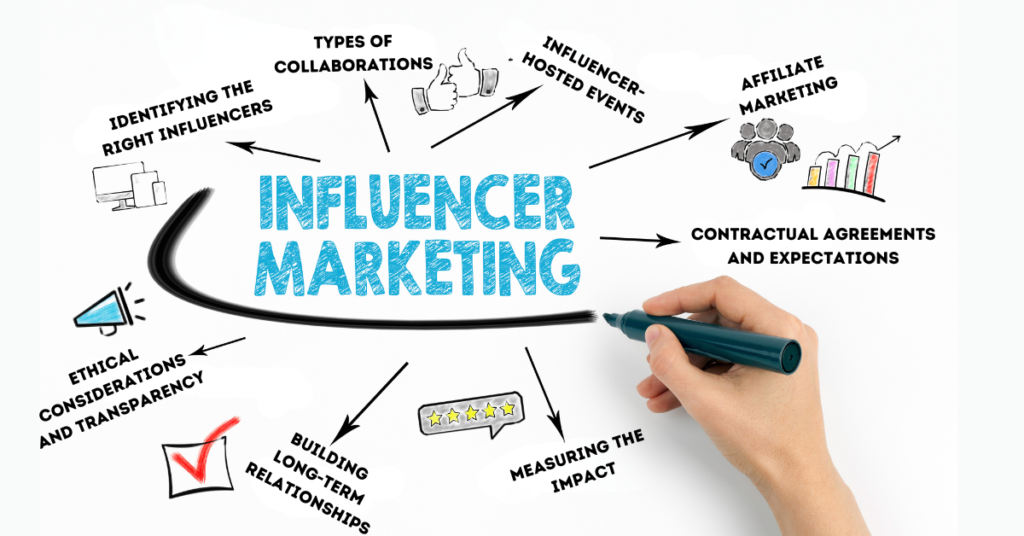
1. Identifying the Right Influencers
- Relevance to Architecture and Design:
- Look for influencers who specialize in architecture, interior design, lifestyle, or real estate, as their audience is more likely to be interested in your services.
- Consider local influencers for a more targeted approach, especially if your work is region-specific.
- Engagement and Authenticity:
- Evaluate influencers not just by the number of followers, but by their engagement rates (likes, comments, shares) and the quality of their interactions.
- Seek out influencers whose content style and values align with your brand’s ethos.
2. Types of Collaborations
- Project Features:
- Have influencers feature your completed projects or design concepts on their platforms, providing a narrative that showcases your expertise and creativity.
- Social Media Takeovers:
- Arrange for influencers to ‘take over’ your social media accounts for a day or a specific event, bringing their unique perspective and audience to your brand.
- Joint Content Creation:
- Collaborate on creating content like blogs, videos, or webinars where both you and the influencer contribute insights and perspectives on architectural topics.
3. Influencer-Hosted Events
- Virtual Tours and Q&A Sessions:
- Influencers can host virtual tours of your projects or Q&A sessions where they discuss your designs and answer questions from their followers.
- Event Appearances:
- Invite influencers to your architecture events or launches, where they can provide live coverage or post-event insights to their audience.
4. Affiliate Marketing
- Referral Programs:
- Implement a referral program where influencers receive a commission for clients they refer to your firm.
- This incentivizes influencers to actively promote your services.
5. Contractual Agreements and Expectations
- Clear Contracts:
- Define the terms of the partnership clearly in a contract, including deliverables, timelines, and compensation.
- Ensure both parties are clear on the expectations and outcomes desired from the partnership.
6. Measuring the Impact
- Performance Tracking:
- Track key metrics like website traffic, social media engagement, and inquiry rates resulting from the influencer partnership.
- Use unique tracking links or promo codes to accurately measure the impact.
7. Building Long-Term Relationships
- Beyond One-Off Campaigns:
- Aim to build long-term relationships with influencers, as sustained collaborations can yield more authentic and impactful promotion.
- Regular check-ins and feedback sessions can help nurture these relationships.
8. Ethical Considerations and Transparency
- Disclosure:
- Ensure that influencers disclose the partnership to their audience, maintaining transparency as per advertising standards.
9. Exploring Niche Platforms
- Beyond Mainstream Social Media:
- Look into niche platforms or forums dedicated to architecture and design where influencers might have a strong presence.
By leveraging influencer partnerships, architects can effectively enhance their brand visibility and credibility. It’s essential to approach these collaborations strategically, ensuring a good fit between the influencer’s audience and your target market. The goal is to create genuine, engaging content that resonates with both your existing audience and the influencer’s followers.
Online Public Relations for Architects
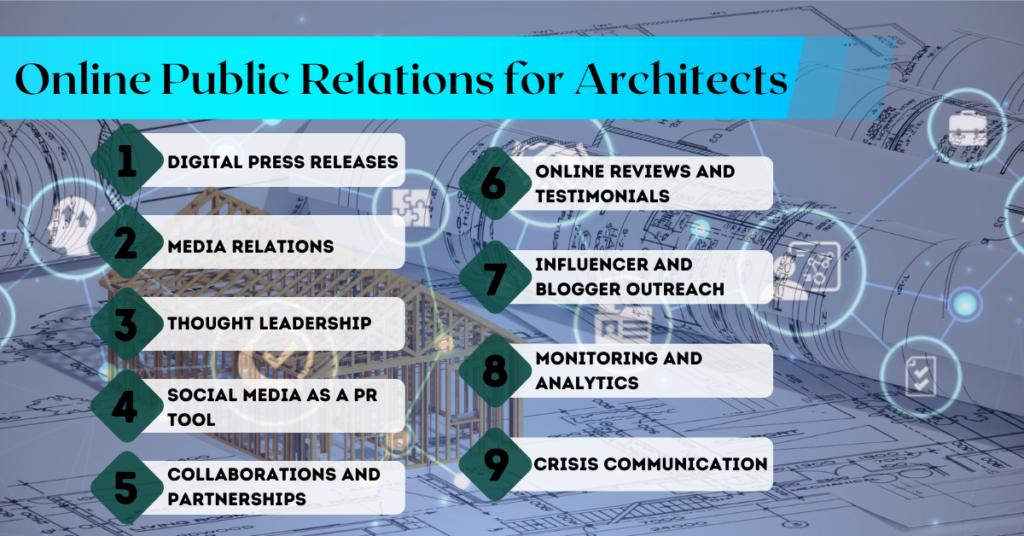
Online Public Relations (PR) is a strategic communication process that builds mutually beneficial relationships between organizations and their publics. For architects, online PR can be a pivotal tool in shaping their brand image, increasing visibility, and establishing credibility in the industry. Here’s how architects can effectively utilize online PR:
1. Digital Press Releases
- Newsworthy Content:
- Craft press releases for significant announcements like winning a prestigious architectural award, launching a revolutionary design project, or expanding your firm.
- Highlight unique aspects of your work, such as innovative sustainable practices or community-focused designs.
- Distribution Platforms:
- Utilize online press release distribution services to reach a wider audience, including journalists, bloggers, and industry professionals.
- Target architecture-specific and local news outlets for more focused exposure.
2. Media Relations
- Building Relationships:
- Cultivate relationships with journalists and editors who cover architecture and design.
- Regularly engage with them, providing insights and comments on industry trends.
- Responsive Communication:
- Be responsive to media inquiries, offering prompt and helpful information.
- Position yourself as a reliable source for expert commentary on architectural matters.
3. Thought Leadership
- Expert Articles and Blogs:
- Publish articles and blogs on your website and LinkedIn, discussing industry trends, design philosophy, and innovative architectural solutions.
- Share these pieces with media contacts and on social media to increase reach.
- Speaking Engagements:
- Seek opportunities to speak at industry conferences, webinars, and panel discussions. These engagements position you as a thought leader in the field.
4. Social Media as a PR Tool
- Engaging Storytelling:
- Utilize social media platforms to tell compelling stories about your projects, design process, and firm culture.
- Share behind-the-scenes glimpses and client testimonials to create an engaging narrative.
- Reputation Management:
- Monitor social media for mentions of your firm and respond appropriately to both positive and negative comments.
- Use social media to address any misconceptions or negative press promptly.
5. Collaborations and Partnerships
- Industry Partnerships:
- Collaborate with other firms, design schools, or industry organizations on projects or events. Publicize these collaborations through various online channels.
- Community Engagement:
- Get involved in community projects or charitable initiatives and share these efforts online, demonstrating your firm’s commitment to social responsibility.
6. Online Reviews and Testimonials
- Leveraging Positive Reviews:
- Encourage satisfied clients to leave reviews on platforms like Google My Business or Houzz.
- Showcase positive testimonials on your website and social media.
7. Influencer and Blogger Outreach
- Influencer Collaborations:
- Partner with architecture and design influencers or bloggers to feature your projects or write about your firm.
- This can lead to increased exposure to a relevant and engaged audience.
8. Monitoring and Analytics
- Track Online Presence:
- Regularly monitor the web for mentions of your firm using tools like Google Alerts or Mention.
- Analyze the sentiment and reach of these mentions to gauge the effectiveness of your PR strategies.
9. Crisis Communication
- Crisis Management Plan:
- Have a plan in place for managing negative events or press. This includes designated spokespersons and prepared statements.
- Respond quickly and transparently to mitigate any potential damage to your reputation.
By implementing these online PR strategies, architects can build a strong and positive brand presence online. This not only enhances their reputation but also opens up opportunities for new projects and collaborations. The key is to maintain consistent, engaging, and authentic communication across all digital platforms.
By strategically leveraging these digital marketing channels, architects can significantly enhance their online presence, reach a wider audience, and ultimately drive more business. It’s important to continuously monitor and adjust these strategies based on performance metrics and evolving market trends.
Optimizing for Conversion
Optimizing for conversion is about turning visitors to your digital platforms, whether it’s your website, social media profiles, or email campaigns, into actual clients or leads. For architects, this involves a strategic approach that not only attracts attention but also compels the audience to take the desired action, such as scheduling a consultation or requesting a quote. Here’s how you can enhance conversion rates:
1. User-Friendly Website Design
- Intuitive Navigation:
- Design your website with clear, logical navigation to help visitors find the information they need quickly.
- Include a sitemap and well-categorized menus focusing on your services, portfolio, and contact information.
- Responsive Design:
- Ensure your website is optimized for all devices, especially mobiles, as a significant portion of users browse on handheld devices.
- Fast Loading Speed:
- Optimize images and use efficient coding practices to ensure your website loads quickly, reducing the bounce rate.
- Engaging Visuals:
- Use high-quality images and videos of your projects. Consider incorporating virtual tours or interactive 3D models of your designs.
2. Clear and Compelling Calls to Action (CTAs)
- Visibility:
- Place CTAs in prominent locations on your website, such as headers, the center of the homepage, and at the end of relevant content.
- Clarity and Urgency:
- Use clear, action-oriented language. Phrases like “Book Your Free Consultation Now” or “Get a Custom Design Quote Today” create a sense of urgency.
- A/B Testing:
- Test different CTA designs, placements, and messages to determine which combinations are most effective in driving conversions.
3. High-Quality Content
- Educational Material:
- Provide value through blogs, whitepapers, and case studies that showcase your expertise and past successes.
- Use this content to address common questions or challenges faced by your target audience.
- Video Content:
- Videos can be a powerful tool to engage visitors and explain complex architectural concepts or project showcases in an accessible way.
4. Lead Capture Strategies
- Online Forms:
- Include contact forms on your website, making it easy for visitors to get in touch.
- Offer something of value in exchange for their contact information, like a free initial design consultation or a downloadable design guide.
- Newsletter Sign-ups:
- Encourage visitors to sign up for your newsletter for regular updates, tips, and insights into your work.
5. Trust Signals
- Testimonials and Reviews:
- Display client testimonials and reviews prominently on your website to build credibility.
- Awards and Certifications:
- Showcase any industry awards, recognitions, or certifications to reinforce your professional standing.
6. Analytics and Continuous Improvement
- Website Analytics:
- Use tools like Google Analytics to track visitor behavior, identify which pages are most effective at driving conversions, and understand where you might be losing potential leads.
- Regular Updates:
- Continuously update your website based on analytics data and evolving best practices in web design and user experience.
By focusing on these areas, architects and architecture firms can significantly improve their conversion rates, turning online interest into tangible business opportunities. It’s about creating a seamless, engaging online experience that guides potential clients towards committing, whether that’s scheduling a meeting, requesting more information, or subscribing to ongoing communications.
Conclusion
Digital marketing for architects is not just about having an online presence; it’s about strategically leveraging various channels and tools to build brand awareness, engage with potential clients, and convert them into loyal customers. By understanding the marketing funnel, utilizing the right mix of digital channels, and continually optimizing for conversions, architects can significantly enhance their online visibility and business growth. Remember, in the digital world, your portfolio is just a click away from your next big project. Embrace these strategies to build a robust digital presence and watch your architecture firm thrive.
Web Zodiac is your partner in marketing efforts. Let us help you harness the power of digital marketing to expand your reach, showcase your unique designs, and grow your client base.
📞 Call us at +91-9810174698 or 📧 email info@webzodiac.com to start your digital transformation journey today!

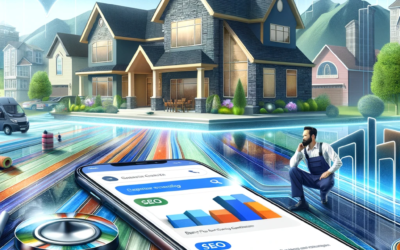

0 Comments